Sunday, 7 September 2025, Let the touring begin! Edinburgh, Stirling Castle
Written 28 September 2025
Today the actual Tauck tour begins.
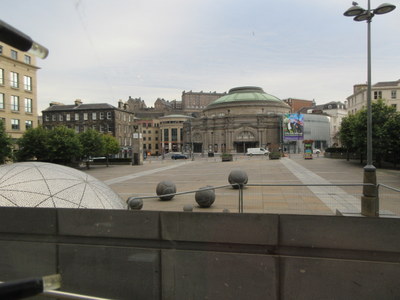
 At the left here is the view from the hotel's restaurant across Festival Square to Usher Hall (with the large green dome), home of the Royal Scottish National Orchestra. To the left of it (with the lower, smaller green dome) is the Traverse Theater, and to the left of that you can just make out Shakespeare's, where we had lunch the day before. The mass looming over all of these is part of Edinburgh Castle.
At the left here is the view from the hotel's restaurant across Festival Square to Usher Hall (with the large green dome), home of the Royal Scottish National Orchestra. To the left of it (with the lower, smaller green dome) is the Traverse Theater, and to the left of that you can just make out Shakespeare's, where we had lunch the day before. The mass looming over all of these is part of Edinburgh Castle.
The right-hand photo shows the vehicle entrance to the hotel, a floor below and on the side away from the square. That's where the airport limo dropped us off and where we boarded buses for tours.
Eager to get in sync with the new time zone (and, of course, as an afficionado of hotel breakfasts) I got up for the hotel breakfast, which opened at 7 am. Because this is the UK, my room is equipped with an electric kettle, so I made myself a pot of tea to take to the dining room. Good thing, too, as the coffee dispenser in the dining room was broken and the only water available for tea was waiting (read "cooling") in carafes, teabags on the side.
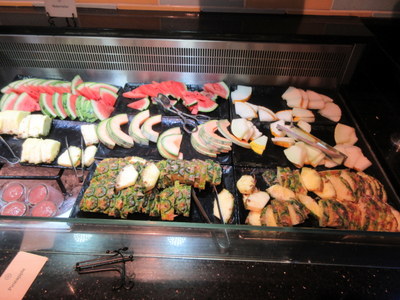
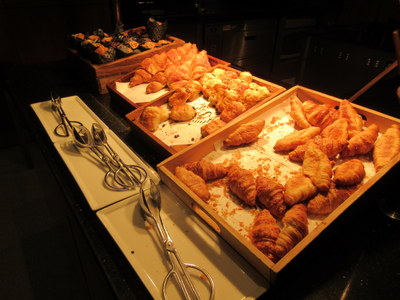 But I think I get to quit grumbling today, as the hotel's "continental buffet" was great: lots of cut fruit (including Canary melon! tomorrow, maybe ripe Canary melon,), whole fruit, yogurt, cereals and amendments, fruit juices, breads, good butter, good jam, Viennoiseries, cold meats (salami, raw ham, cooked ham, smoked salmon, turkey) and cheeses, salad greens and raw vegetables, and smoothie of the day (something fluffy and purple).
But I think I get to quit grumbling today, as the hotel's "continental buffet" was great: lots of cut fruit (including Canary melon! tomorrow, maybe ripe Canary melon,), whole fruit, yogurt, cereals and amendments, fruit juices, breads, good butter, good jam, Viennoiseries, cold meats (salami, raw ham, cooked ham, smoked salmon, turkey) and cheeses, salad greens and raw vegetables, and smoothie of the day (something fluffy and purple).
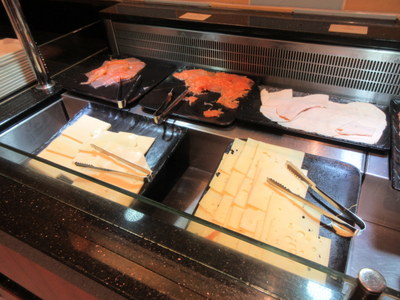
 I went light on the buffet, then, from the menu, had "eggs Florentine"—a little round bun split and toasted, then topped with sautéed baby spinach, poached eggs, very mild Hollandaise, and pea sprouts.
I went light on the buffet, then, from the menu, had "eggs Florentine"—a little round bun split and toasted, then topped with sautéed baby spinach, poached eggs, very mild Hollandaise, and pea sprouts.
David, not an afficionado of breakfast, or even of getting up in the morning at all, slept in. We met, as agreed, for an early lunch in the bar, which currently calls itself "One Square Bar," but is clearly labeled on the outside door as "All Bar One." Alas, it turns out that around here kitchens don't open for lunch until noon. We didn't want to wait, since our first tour started at 1 pm, so we ordered from the breakfast menu, which included scones, clotted cream, and strawberry jam—the classic British "cream tea," usually served in the afternoon. It was a lovely cream tea, and I wish I'd remembered to take a photo before we scarfed it down.
I was intrigued, though, by an item on the bar's lunch menu, under starters: haggis bonbons. Bonbons? Okay, bite-sized pieces of haggis, maybe on sticks, to nibble with drinks? Anyway, despite my Scottish heritage, I'd never tasted haggis and hoped to on this trip.
After lunch/tea, we adjourned to the lower lobby level to meet the rest of our group, John (our driver for the day), Annika (our local tour guide for our time in Edinburgh), and Tour Director Stefano Calcagni. Yes, Stefano is Italian, but he says he's now lived in the UK for longer than he lived in Italy. Still, I noticed, when he counted us (at least twice every time we boarded the bus), he still counts in Italian.
Lately, we've been watching a British cop show called Annika, set in Glasgow and featuring a policewoman named Annika who is half Scottish and half Norwegian. Our guide Annika is half Scottish and half Swedish. But she doesn't look anything like TV actress Nicola Walker. Fun coincidence, though.
Our group was small this time—only 18 people, because two couples cancelled at the last minute—and we all seemed pretty copacetic.
Once we were all name-tagged (in general Tauck doesn't believe in name tags, because you're supposed to introduce yourself to people, but our list of participants hadn't been distributed yet, so Stefano made an exception for the day), we were herded onto the bus and set off on our first tour of the trip, to Stirling Castle, about an hour from Edinburgh. As on previous Tauck trips, seating was assigned, so that Stefano could rotate us around through different parts of the the bus rather than having the same people get the front seats every time. Rather than make us figure it our from a chart on the door, he just hung tags with our names above our rows. On the way, Annika started filling us in on background info about the area.
- The population of Edinburgh is about 523,000.
- The largest cultural festival in the world, the Edinburgh Fringe Festival, has just ended. A million people come for it every year. It started when somebody organized an annual music festival, but folks from other branches of the cultural arts (e.g. theater, dance, visual arts) came and set themselves up around the fringes of it. After a few years, the fringes dwarfed the original and the Fringe Festival was born.
- The Royal Edinburgh Military Tattoo also takes place in August on the esplanade of the castle and draws military bands (especially bagpipers) from all over the world, togther with hundreds of thousands of spectators. So August is festival season in Edinburgh, and according to Annika, September is "whew" season.
- September isn't all that peaceful, though. Edinburgh has two major universities, Edinburgh U. and Edinburgh-Napier, and we were there during move-in week for the new students.
- Scotland has four "ancient universities": St. Andrews (founded in 1413), Glasgow (1451), Aberdeen (1495), and Edinburgh (1582).
- Scotland has 5.5 million people and England has 100 million, so the Scots are particularly pround of any athletic victories over the English.
- The scots divided the country into three regions: Lowlands, Highlands, and Islands.
- Gaelic is spoken in both Ireland and Scotland, but it's pronounced "gay-lick" in Ireland and "Gallic" (the "a" as in "pallid") in Scotland. They are spoken rather differently but are mostly mutually intelligible. Gaelic is not taught in the schools in Scotland, so it hasn't survived as vibrantly as it has in Ireland.
- The most common Gaelic toast is "Slàinte Mhath" (pronounced slan-cha va) means "to your good health"; it's often shortened to just "Slàinte" (pronounced slan-cha).
- The final Downton Abbey movie premiered here a couple of days ago.
- This late in the year, most of the fields we passed had been harvested, so saw l=mostly stubble. Annika said that a lot of barley is grown, for production of beer and whisky, but they also grow oilseed rape for canola oil and wheat for making shortbread. She agrees that Walkers is only okay shortbread. She prefers Crystal shortbread, but also makes her own out of flour, sugar, and butter; she browns her butter first, then chills it, claiming the butter must be hard. My own recipe calls for very soft (but not melted) butter.
- We also passed many fields of sheep with black heads.
- Every brewery claims their barley is Scottish, but the amount consumed excedes the amount grown, so some must be imported.
- Scotland also grows pears and plums, vegetables, and berries, especially strawberries and raspberries. The longest days are light from 4:45 am to 11 pm. The strawberries served at Wimbledon are always from Scotland.
- Annika pointed out some small artificial hills by the side of the road. They were heaps of tailings from mining. But, she said, in the 1960's "they learned how to extract surface oil," so no tailings are produced. Most the little tailing mounds are gone but they kept a few as memorials to the industrial past.
- The largest motorways in Scotland have only two lanes each way. The speed limit for cars is 70 miles/hour—in Scotland, they still use miles.
- Hotels have AC but almost no private homes do.
- Whisky porridge is oatmeal with cream, honey, and whisky. Annika recommends it.
As we passed Linlithgow Palace, which I didn't get a photo of, Annika told us a bit about Mary Queen of Scotts. Both she and her father (James V) were born at Linlithgow. Because her father died when she was only six days old, and she was his only legitimate child, she was crowned at 9 days old. Her mother, Marie de Guise, became "Queen Mary" and raised her. Marie didn't feel safe because of attempts on the baby's life, so she stayed and ruled as regent but sent the baby to France.
Mary was a redhead and very tall for the time (1500's), at 5'11". She married François, the French dauphin, in 1588,when she was 15 (he was 14). He became King François II the next year (making Mary the Queen Consort of France), but he died the year after that. Widowed at 17, and facing a mother-in-law (Catherine de Medici!) who didn't like her, Mary moved back to Scotland and stayed at Holyroodhouse. Unfortunately, Scotland had gone Protestant, and Mary was a staunch Catholic. She wasn't forced to abdicate until 1567, but things did not go well.
In Falkirk, as we neared Stirling, we drove right by the Kelpies, two monumental (not to say gigantic, 98 feet high) steel statues of horses' heads, by Andy Scott, who used to live in Glasgow but is now in Los Angeles. Kelpies are shape-shifting sea creatures, really mean ones, who pose as horses and lure men to their deaths in the sea. The statues are modeled on two real Clydesdale horses (called the Duke and the Baron). I tried to get a photo, but I was on the wrong side of the bus, so all I got was a section of horse neck and the back of Stefano's head.
In the 13th and 14th centuries, Scotland fought a couple of wars of independence from England. Each war was years long, and they were separated only by a short-lived treaty and a couple of years of relative peace. A couple of the battles of the first were fought at Stirling: the battle of Stirling Bridge (1297), where William Wallace (you know, Mel Gibson) defeated the British, and the battle of Bannockburn (1314), where Robert the Bruce (you know, Angus Macfadyen) did the same thing.
At the battle of Stirling Bridge, the bridge formed a bottleneck that allowed William Wallace to overcome the superior English numbers. William Wallace was not of noble birth, and his English opponent, Edward I, did not like that. Then Edward II attempted to lift the siege of Stirling Castle and avenge his father's earlier defeat and ran up against Robert the Bruce, who became Robert I of Scotland, at Bannockburn.
But then, in the 1746 battle of Culloden, outside inverness, the English pretty much settled the Scots' hash, winning a decisive victory that ended the hopes of a restoration of the Catholic Stuarts to the throne and led to years of brutal suppression of Scottish culture and the clan system. Bonnie Prince Charlie (grandson of James II of Scotland, aka James VII of England) was forced to flee back to France, and the crown passed to William and Mary, both Protestant, who ruled jointly. William had his own claim to the throne (he was the grandson of James I (of Scotland, VI of England), whose daughter had married a Prince of Orange), and it was reinforced by his marriage to Mary, daughter of James II/VII. She was a Protestant, even though her father was Catholic. The battle of Culloden figures largely in the Outlander series.
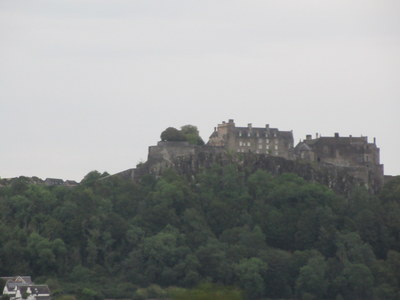
 And here, at last, is Stirling Castle, up on its hill as we approached. Passing through the town on the way up the hill, we passed the old King's Hunting Ground, now a golf course (Annika assusred us that Mary Queen of Scots played golf, but she didn't say where). Also rows of brown victorian villas with lots and lots of chimneys.
And here, at last, is Stirling Castle, up on its hill as we approached. Passing through the town on the way up the hill, we passed the old King's Hunting Ground, now a golf course (Annika assusred us that Mary Queen of Scots played golf, but she didn't say where). Also rows of brown victorian villas with lots and lots of chimneys.
The town even has an Albert Hall, named (like the one in London) for Victoria's Albert. I didn't get a good photo of the statue of Rob Roy McGregor, whom Annika described as like Robin Hood except that he kept the money he stole. He used to have a sword in his raised hand, but Health and Safety made them take it down.
She also pointed out a church that had a schism but couldn't afford a new building, so they built a wall down the middle and sat on opposite sides of the old building for services.
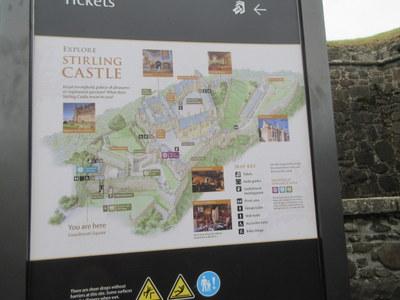
 Near the entrance to the castle was this helpful map of the complex. We entered at the lower left corner. At the size shown here, you can't make out much, but if you locate the largest tree on the map (to the right of the left-most inset picture), you'll have located the Queen Anne Garden (shown here at the right), where we paused to regroup.
Near the entrance to the castle was this helpful map of the complex. We entered at the lower left corner. At the size shown here, you can't make out much, but if you locate the largest tree on the map (to the right of the left-most inset picture), you'll have located the Queen Anne Garden (shown here at the right), where we paused to regroup.
At the far end is the 200-year-old beech tree portrayed on the map. The dense borders edging the lawn were planted with a dizzying variety of flowers. I took a bunch of photos, which, as time permits, I'll run through "Picture This" to make sure I can identify everything.

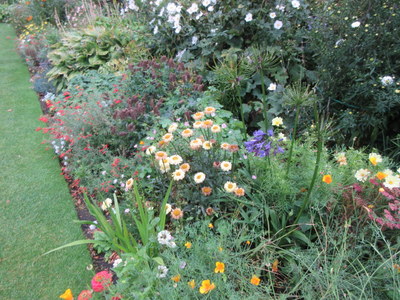 Towering over the garden was this building where some of the royal appartments were.
Towering over the garden was this building where some of the royal appartments were.
At at the right is a sample of the richly floral plantings that bordered the lawn.
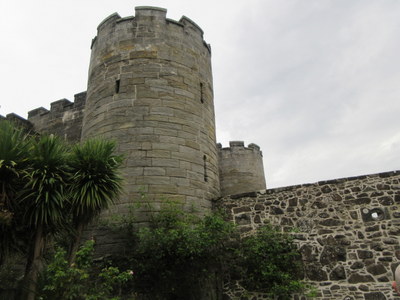
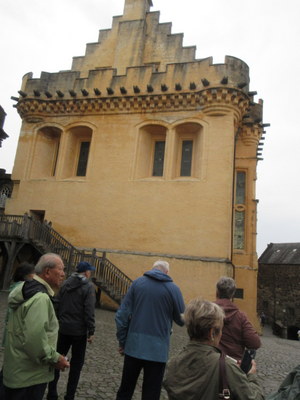 The castle now has two defensive towers. It used to have eight, and all of them were taller than they are now—the fortifications were partially destroyed several times, mainly by retreating troops hoping to deny the advancing army their use.
The castle now has two defensive towers. It used to have eight, and all of them were taller than they are now—the fortifications were partially destroyed several times, mainly by retreating troops hoping to deny the advancing army their use.
Most of the buildings are gray-black in color near the top but blonder near the bottom (you can see the effect clearly in the wall visible above the garden). The paler color is the original and is visible now mainly where it has been partly sheltered from weathering and pollution. The stone can't be cleaned because it's too soft for sandblasting.
The building at the right here (the Great Hall) is painted. It's the only one now, but originally, they would all have been painted, in a variety of colors.

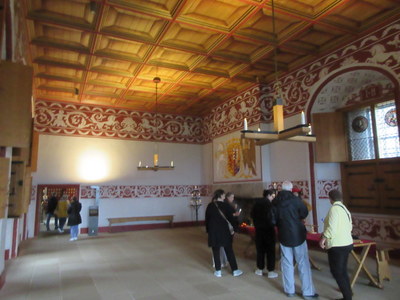 At the left here is the interior of the great banquet hall—long trestle tables would have been set up.
At the left here is the interior of the great banquet hall—long trestle tables would have been set up.
In the building above the gardens, here is the "queen's outer hall"—the king and queen each had an outer hall, an inner hall, and a bed chamber, which those wishing to see them had to progress through. Few people made it past the outer hall.
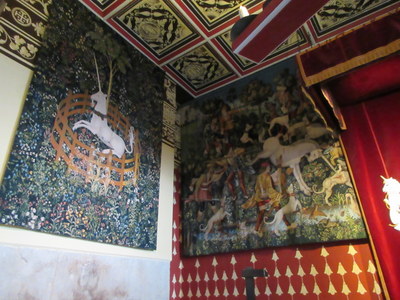
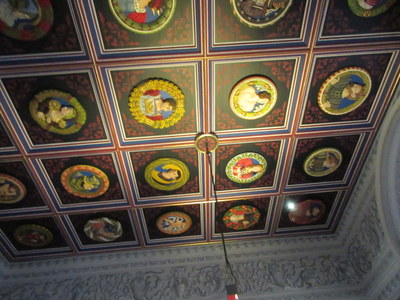 The queen's bedchamber is decorated with copies of the unicorn tapestries. Weavers studied the ones at the Cloisters in New York, then worked for years, both at Stirling Castle and in studios elsewhere, to make authentic copies. The large bed in the queen's bedchamber was only for ceremonial use; she actually slept in a small room off to one side.
The queen's bedchamber is decorated with copies of the unicorn tapestries. Weavers studied the ones at the Cloisters in New York, then worked for years, both at Stirling Castle and in studios elsewhere, to make authentic copies. The large bed in the queen's bedchamber was only for ceremonial use; she actually slept in a small room off to one side.
The ceiling of the king's bedchamber is decorated with the famous Stirling Heads," wooden portraits carved in high relief. Some have had to be restored. A whole exhibition about them was on display elsehwere in the complex, but we didn't have time to visit it.
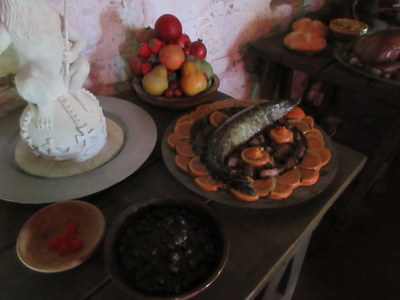
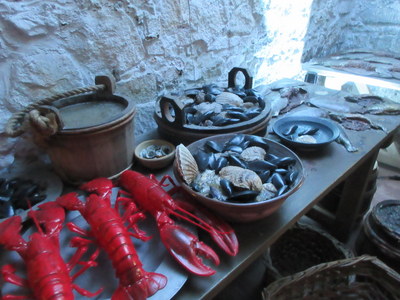 After a quick turn through the royal chambers, I of course, made a bee line to the restored kitchens. Signage at the entrance made clear that only a small fraction of the original kitchens was on display. Unfortunately, the lighting was very dim, and not many of my photos came out well. At the left here is a (fake) pike arrayed on a bed of (fake) orange slices and (I think) sausages. At the right, lobsters, various bivalves, and fish in the process of being cleaned. Costumed mannequins were hard at work in the various rooms.
After a quick turn through the royal chambers, I of course, made a bee line to the restored kitchens. Signage at the entrance made clear that only a small fraction of the original kitchens was on display. Unfortunately, the lighting was very dim, and not many of my photos came out well. At the left here is a (fake) pike arrayed on a bed of (fake) orange slices and (I think) sausages. At the right, lobsters, various bivalves, and fish in the process of being cleaned. Costumed mannequins were hard at work in the various rooms.
The presentation was a little disappointing, as those who wrote the text didn't seem to be in very good communication with those making the models. For example, the lists of vegetables commonly served didn't overlap very well with the assortment of model vegetables.
One fascinating info panel revealed that for festive occasions, pies with top and bottom crusts were sometimes baked with nothing inside but bran. Once the crusts were firm and crisp, the top crust was removed, the bran dumped out, and the pie reassembled with small live birds inside. At the table, when the crust was broken, the birds flew out! That makes a whole lot more sense of a nursery rhyme I heard about a million times from my Scottish grandmother! "Sing a song of sixpence, a pocket full of rye. Four and twenty blackbirds baked in a pie. When the pie was opened, the birds began to sing. Wasn't that a dainty dish to set before a king?"

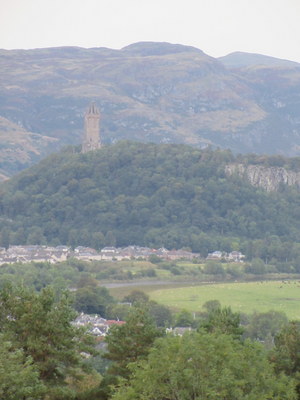 After the kitchens, I climbed up onto the cannon platform behind the battlements. From there, to the north, I could see the National Wallace Monument, a tower built long after the battle, in Victorian times. I hope you can make it out in this somewhat telephotoed shot.
Behind is are the Ochil Hills. Farther away, and probably out of the shot to the left, is Scotland's first national park, the Trossachs.
After the kitchens, I climbed up onto the cannon platform behind the battlements. From there, to the north, I could see the National Wallace Monument, a tower built long after the battle, in Victorian times. I hope you can make it out in this somewhat telephotoed shot.
Behind is are the Ochil Hills. Farther away, and probably out of the shot to the left, is Scotland's first national park, the Trossachs.
So I don't feel as though I've conveyed just what a big deal Stirling Castle is to Scotland. The oldest remaining part of the structure is from 1380, but its history goes back to way before the Romans, and its Wikipedia page goes on and on. It was built and occupied by generations of Scottish kings. So if you're interested in more of its history and significance, do Google it to find more info.
We didn't have time to see everything there—for example, the tapestry museum, the display of historic jewelry that I breezed right by on my way to the queen's outer hall, the vaults and the Stirling heads gallery, and the regimental museum, presumably of the Argyll and Sutherland Highlanders (Princess Louise's), who were based there until 1964, when they left so that the castle cold be properly opened to the public.
As we reassembled in the queen's garden to return to the bus, Annika pointed out the Saltire, the blue and white Scottish flag. Scotland has its own flag, but its not included in the pattern on the Union Jack, because Scotland is only a principality and not a kingdom. It joined with England, through the Act of Union in 1707, to form the Kingdom of Great Britain.
She also said that, somewhere in the castle, there's a lion's den; no one is sure whether the actual lion was ever here, but the den was a gift from a foreign potentate.
She told us about Italian alchemist John Damian (anglicized from Giovanni Damiano de Falcucci), in the court of James VI. He stood on a rampart with home-built wings covered with chicken feathers and leaped off. Luckily, he landed directly below in a dung heap and survived. He said that, next time, he'd use eagle features, but somehow he never got around to trying it.
Finally, she said that this region of Scotland has long had a reputation for producing fine stonemasons. It seems the American White House was built mostly by Scottish masons./p
!-- I could make steak and kidney pot pies for the freezer and bake one for myself now and then. -->
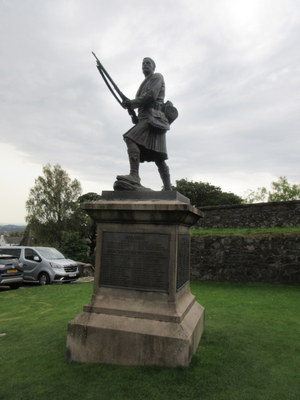
 On the way out, I got this shot of the dry moat that surrounds the castle on the one side that isn't defended by steep cliffs.
On the way out, I got this shot of the dry moat that surrounds the castle on the one side that isn't defended by steep cliffs.
Nearby was this statue of a rifleman standing at the ready. It's a memorial to the Argyll and Sutherland Highlanders who died in the South African War of 1899 to 1902 (the Boer War).
Then it was back into the bus and back the way we came. I spotted a few jackdaws at the castle, and in the fields we drove past were some Herefords and belted Galloways. To my surprise, the latter were red and white—I didn't know belted Galloways came in anything but black and white. And I started seeing ordinary white sheep, without black heads, then sheep with just black faces. Lots of large round hay bales, wrapped and unwrapped were waiting by the side of the road for pickup.
Lots of pines were mixed in with the hardwards along the roads, as were stands of what look like tamarisk. None of the trees were in obvious plantations.
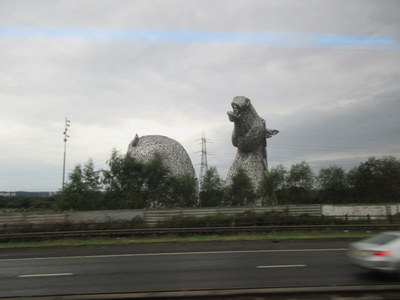
 Driving the other way, my seat was on the right side of the bus, so I got a more success shot of the Kelpies, though the trees cut off the lower part of the view.
Driving the other way, my seat was on the right side of the bus, so I got a more success shot of the Kelpies, though the trees cut off the lower part of the view.
And I was intrigued by the pedestrian rotaries! I hope you can make out how this one, shown at the right, works. All the sidewalks paralleling the roads entering the rotary dip down to pass under the rotary, which is slightly raised. They meet in the middle, which is slightly sunken, in a sort of pedestrian rotary, so that walkers can enter from any direction, cross under, and exit in any other direction, without ever having to cross a street! We passed several of them.
It was Stefano's turn to narrate during the ride back.
- We'll be in London the same time Trump will be there. Hope he stays at the US embassy residence and not at the Savoy with us!
- The tour we're on has been run 44 times since last April! Since 1981, it has been run over 1000 times, despite the COVID hiatus.
- Stefano lives in London, so to meet us in Edinburgh, he took the fast train, which runs every half hour and got him there is 4 hours 18 minutes. It cost only 45 pounds because he booked it way in advance. It would be a 7.5-hour drive of a 45-minute flight.
On the way, he presented each couple with a handsome, plastic-encased medallion commemorating the Tauck company's 100th year of tours. As part of this year's celebration, the company had allocated him a particuarly generous budget for swag—he threatened to buy us enough stuff at our various stops that we would have to acquire an extra suitcase to get it all home!

 Back at the hotel, after a little time to freshen up in our rooms, we reassembled once more, this time for cocktails and munchies before our official welcome dinner. I think the little puffs pictured at the left are the Ayrshire ham and Isle of Mull Cheddar beignets.
Back at the hotel, after a little time to freshen up in our rooms, we reassembled once more, this time for cocktails and munchies before our official welcome dinner. I think the little puffs pictured at the left are the Ayrshire ham and Isle of Mull Cheddar beignets.
Stefano had promised us a special surprise guest, and my guess was right. We were visited by a bagpiper fitted out in the full-dress kilt! He introduced himself as "Robbie" and played several tunes. We wished he'd played more, but he said he was worried about damaging our hearing, playing a full-size bagpipe in a closed room. Instead, he told us a good deal about the bagpipe in general, and about his beautiful antique instrument in particular, and regaled us with stories of his career as a piper.
In answer to a question, he said his favorite Scotch whisky is Glen Firclas, which his father described as tasting like an angel was peeing on your tongue. He prefers the 15-year old, which he feels has the the right balance between age and price.
At the appointed hour, he fired up the pipes again and ceremoniously piped us to dinner, leading the way down the hall to our private dining room.

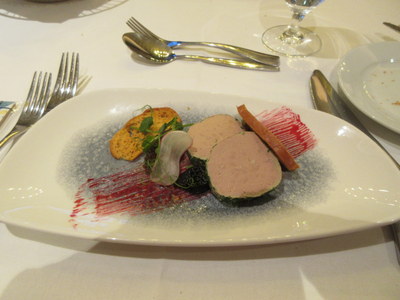 Waiting on a small side table was, yes!, an actual haggis, encased, as is traditional, in a sheep's stomach. Robbie laid aside his pipes, picked up a knife, and with great ceremony, stabbed the haggis. Then he picked it up with both hands and squeezed from the bottom. It split open, and the contents welled out. He turned it over and dropped it quickly back onto the table, muttering under his breath, "It wasn't supposed to do that." I have no idea what he expected to happen!
Waiting on a small side table was, yes!, an actual haggis, encased, as is traditional, in a sheep's stomach. Robbie laid aside his pipes, picked up a knife, and with great ceremony, stabbed the haggis. Then he picked it up with both hands and squeezed from the bottom. It split open, and the contents welled out. He turned it over and dropped it quickly back onto the table, muttering under his breath, "It wasn't supposed to do that." I have no idea what he expected to happen!
But meanwhile, servers had been circulating among the tables dropping off bowls of, yes!, haggis bonbons! They were a little bigger than golf balls, crumbed and fried, and served warm. I took one and passed the bowl, and it was delicious! Like a soft, spreadable pâté with a fair percentage of mild liver in it. Only one other person at the table even took one; she put it on her plate, cut off a tiny sliver to taste, and left the rest. I ate a second one and then peered wistfully at the remaining three, but I knew I had a three-course dinner coming, and eventually, they were taken away. The others all admitted that it wasn't so much the taste (which they hadn't even tried) but the idea of what was in it. But thanks to my Scottish grandmother I have no qualms about livers, kidneys, and such. Lung was a new one on me, but it was all chopped so fine you couldn't possibly separate the components. I was hoping David's experience with French food would sway him, but no such luck.
The first course that David and I chose (over smoked haddock and leek soup and grilled artichokes with tapenade) was "chicken liver parfait, prune & brioche salad," which turned out to be chicken liver pâteacute; with prunes, brioche toasts, and a little salad. Very good.
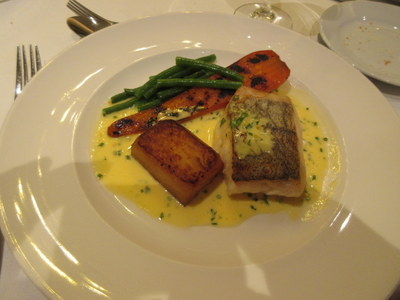
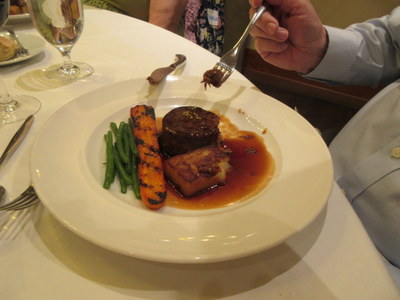 For the main course I chose herb-crusted hake (Merluccius merluccius, aka Pacific whiting) with fine beans, confit potatoes and saffron and vermouth sauce. Also excellent.
For the main course I chose herb-crusted hake (Merluccius merluccius, aka Pacific whiting) with fine beans, confit potatoes and saffron and vermouth sauce. Also excellent.
David chose slow-cooked Scottish beef with oxtail jus and the same vegetables. The vegetarian option was a little puff-pastry pie of celery root and sweet onion, with onion soubise sauce.
Not mentioned on the menu was the absolutely outstanding glazed carrot we each got. It was only the first of a long series of truly revelatory cooked carrots we got on this tour. I get the impression it wasn't mentioned on the menu because it just went without saying—you order a main course this time of year in the UK, you get at least one fabulous carrot with it.
 The dessert we both chose was called "bramble trifle," but it was more of a panna cotta with blackberry compote. The other choice was Scottish cheese with sourdough crackers.
The dessert we both chose was called "bramble trifle," but it was more of a panna cotta with blackberry compote. The other choice was Scottish cheese with sourdough crackers.
As you can see from the photos, the job of the junior-most commis in the kitchen is to spend the afternoon painting stripes of something red across all the plates.
Tomorrow Edinburgh castle and a whisky-tasting dinner!
Previous entry
List of Entries
Next entry

 At the left here is the view from the hotel's restaurant across Festival Square to Usher Hall (with the large green dome), home of the Royal Scottish National Orchestra. To the left of it (with the lower, smaller green dome) is the Traverse Theater, and to the left of that you can just make out Shakespeare's, where we had lunch the day before. The mass looming over all of these is part of Edinburgh Castle.
At the left here is the view from the hotel's restaurant across Festival Square to Usher Hall (with the large green dome), home of the Royal Scottish National Orchestra. To the left of it (with the lower, smaller green dome) is the Traverse Theater, and to the left of that you can just make out Shakespeare's, where we had lunch the day before. The mass looming over all of these is part of Edinburgh Castle.
 But I think I get to quit grumbling today, as the hotel's "continental buffet" was great: lots of cut fruit (including Canary melon! tomorrow, maybe ripe Canary melon,), whole fruit, yogurt, cereals and amendments, fruit juices, breads, good butter, good jam, Viennoiseries, cold meats (salami, raw ham, cooked ham, smoked salmon, turkey) and cheeses, salad greens and raw vegetables, and smoothie of the day (something fluffy and purple).
But I think I get to quit grumbling today, as the hotel's "continental buffet" was great: lots of cut fruit (including Canary melon! tomorrow, maybe ripe Canary melon,), whole fruit, yogurt, cereals and amendments, fruit juices, breads, good butter, good jam, Viennoiseries, cold meats (salami, raw ham, cooked ham, smoked salmon, turkey) and cheeses, salad greens and raw vegetables, and smoothie of the day (something fluffy and purple).
 I went light on the buffet, then, from the menu, had "eggs Florentine"—a little round bun split and toasted, then topped with sautéed baby spinach, poached eggs, very mild Hollandaise, and pea sprouts.
I went light on the buffet, then, from the menu, had "eggs Florentine"—a little round bun split and toasted, then topped with sautéed baby spinach, poached eggs, very mild Hollandaise, and pea sprouts.
 And here, at last, is Stirling Castle, up on its hill as we approached. Passing through the town on the way up the hill, we passed the old King's Hunting Ground, now a golf course (Annika assusred us that Mary Queen of Scots played golf, but she didn't say where). Also rows of brown victorian villas with lots and lots of chimneys.
And here, at last, is Stirling Castle, up on its hill as we approached. Passing through the town on the way up the hill, we passed the old King's Hunting Ground, now a golf course (Annika assusred us that Mary Queen of Scots played golf, but she didn't say where). Also rows of brown victorian villas with lots and lots of chimneys.
 Near the entrance to the castle was this helpful map of the complex. We entered at the lower left corner. At the size shown here, you can't make out much, but if you locate the largest tree on the map (to the right of the left-most inset picture), you'll have located the Queen Anne Garden (shown here at the right), where we paused to regroup.
Near the entrance to the castle was this helpful map of the complex. We entered at the lower left corner. At the size shown here, you can't make out much, but if you locate the largest tree on the map (to the right of the left-most inset picture), you'll have located the Queen Anne Garden (shown here at the right), where we paused to regroup.
 Towering over the garden was this building where some of the royal appartments were.
Towering over the garden was this building where some of the royal appartments were.
 The castle now has two defensive towers. It used to have eight, and all of them were taller than they are now—the fortifications were partially destroyed several times, mainly by retreating troops hoping to deny the advancing army their use.
The castle now has two defensive towers. It used to have eight, and all of them were taller than they are now—the fortifications were partially destroyed several times, mainly by retreating troops hoping to deny the advancing army their use.
 At the left here is the interior of the great banquet hall—long trestle tables would have been set up.
At the left here is the interior of the great banquet hall—long trestle tables would have been set up.

 The queen's bedchamber is decorated with copies of the unicorn tapestries. Weavers studied the ones at the Cloisters in New York, then worked for years, both at Stirling Castle and in studios elsewhere, to make authentic copies. The large bed in the queen's bedchamber was only for ceremonial use; she actually slept in a small room off to one side.
The queen's bedchamber is decorated with copies of the unicorn tapestries. Weavers studied the ones at the Cloisters in New York, then worked for years, both at Stirling Castle and in studios elsewhere, to make authentic copies. The large bed in the queen's bedchamber was only for ceremonial use; she actually slept in a small room off to one side.
 After a quick turn through the royal chambers, I of course, made a bee line to the restored kitchens. Signage at the entrance made clear that only a small fraction of the original kitchens was on display. Unfortunately, the lighting was very dim, and not many of my photos came out well. At the left here is a (fake) pike arrayed on a bed of (fake) orange slices and (I think) sausages. At the right, lobsters, various bivalves, and fish in the process of being cleaned. Costumed mannequins were hard at work in the various rooms.
After a quick turn through the royal chambers, I of course, made a bee line to the restored kitchens. Signage at the entrance made clear that only a small fraction of the original kitchens was on display. Unfortunately, the lighting was very dim, and not many of my photos came out well. At the left here is a (fake) pike arrayed on a bed of (fake) orange slices and (I think) sausages. At the right, lobsters, various bivalves, and fish in the process of being cleaned. Costumed mannequins were hard at work in the various rooms.
 After the kitchens, I climbed up onto the cannon platform behind the battlements. From there, to the north, I could see the National Wallace Monument, a tower built long after the battle, in Victorian times. I hope you can make it out in this somewhat telephotoed shot.
Behind is are the Ochil Hills. Farther away, and probably out of the shot to the left, is Scotland's first national park, the Trossachs.
After the kitchens, I climbed up onto the cannon platform behind the battlements. From there, to the north, I could see the National Wallace Monument, a tower built long after the battle, in Victorian times. I hope you can make it out in this somewhat telephotoed shot.
Behind is are the Ochil Hills. Farther away, and probably out of the shot to the left, is Scotland's first national park, the Trossachs.
 On the way out, I got this shot of the dry moat that surrounds the castle on the one side that isn't defended by steep cliffs.
On the way out, I got this shot of the dry moat that surrounds the castle on the one side that isn't defended by steep cliffs.
 Driving the other way, my seat was on the right side of the bus, so I got a more success shot of the Kelpies, though the trees cut off the lower part of the view.
Driving the other way, my seat was on the right side of the bus, so I got a more success shot of the Kelpies, though the trees cut off the lower part of the view.
 Back at the hotel, after a little time to freshen up in our rooms, we reassembled once more, this time for cocktails and munchies before our official welcome dinner. I think the little puffs pictured at the left are the Ayrshire ham and Isle of Mull Cheddar beignets.
Back at the hotel, after a little time to freshen up in our rooms, we reassembled once more, this time for cocktails and munchies before our official welcome dinner. I think the little puffs pictured at the left are the Ayrshire ham and Isle of Mull Cheddar beignets.
 Waiting on a small side table was, yes!, an actual haggis, encased, as is traditional, in a sheep's stomach. Robbie laid aside his pipes, picked up a knife, and with great ceremony, stabbed the haggis. Then he picked it up with both hands and squeezed from the bottom. It split open, and the contents welled out. He turned it over and dropped it quickly back onto the table, muttering under his breath, "It wasn't supposed to do that." I have no idea what he expected to happen!
Waiting on a small side table was, yes!, an actual haggis, encased, as is traditional, in a sheep's stomach. Robbie laid aside his pipes, picked up a knife, and with great ceremony, stabbed the haggis. Then he picked it up with both hands and squeezed from the bottom. It split open, and the contents welled out. He turned it over and dropped it quickly back onto the table, muttering under his breath, "It wasn't supposed to do that." I have no idea what he expected to happen!
 For the main course I chose herb-crusted hake (Merluccius merluccius, aka Pacific whiting) with fine beans, confit potatoes and saffron and vermouth sauce. Also excellent.
For the main course I chose herb-crusted hake (Merluccius merluccius, aka Pacific whiting) with fine beans, confit potatoes and saffron and vermouth sauce. Also excellent. The dessert we both chose was called "bramble trifle," but it was more of a panna cotta with blackberry compote. The other choice was Scottish cheese with sourdough crackers.
The dessert we both chose was called "bramble trifle," but it was more of a panna cotta with blackberry compote. The other choice was Scottish cheese with sourdough crackers.